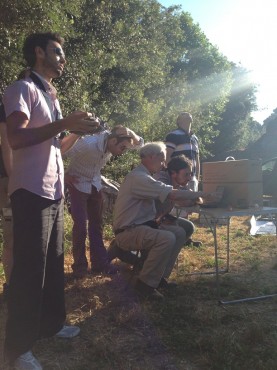Unmanned Aerial Vehicles at Portus

Since the start of excavations by the Portus Project in 2007, aerial photography has played an important role in the recording, analysis and presentation of the research. The ability for the archaeologist to have a bird’s-eye view of an excavation gives the opportunity to see the plan of structures, their relationships with each and alignments which are not visible at ground level. Furthermore, low altitude photography on an excavation gives the opportunity for a number of recording methods to be used, in particular photogrammetry.
The Portus Project has experimented with a number of methods in order to gain the best oblique and vertical photographs of the excavations. These have ranged from helium balloons, cherry-pickers and even a helicopter. However in recent seasons, due to significant technological advances, the project has begun experimenting with using UAVs (Unmanned Aerial Vehicles), popularly known as drones.
Initial work began with testing the stability and functionality of a Parrot AR.Drone (http://ardrone2.parrot.com/). These small light drones, fitted with four rotors, a 3 axis-gyroscope and accelerometer, run over a local Wi-Fi network created between the drone and a device such as a tablet or smartphone. The drone (the Portus Project used the 2.0 version) is fitted with two cameras, a front mounted wide-angle diagonal lens with HD resolution and a smaller vertical camera. The potential for rapidly recording videos and precise photography was immediately apparent, encouraging the project to investigate further using this form of aerial photography.
In the 2013 excavation season the project therefore deployed much larger hexicopter, the DJI Innovations Spreading Wings S800 (http://www.dji.com/product/spreading-wings-s800), fitted with a multirotar stabilisation system. These much more powerful drones can be fitted with a vertically mounted gimbal allowing a much higher resolution digital camera to be fitted to the drone (the project used a Canon PowerShot G15).

The advantages to using a drone for archaeological excavation recording are numerous: the archaeologist can immediately check and guide the position of the drone (both by naked eye and a live video link with the view finder on the camera) allowing the photograph to be taken at the optimal height and position; the photographs can be immediately downloaded in the field; the cost is minimal in comparison to the hire of a platform of a specialist with a helium balloon. There do exist a number of drawbacks, in particular wind speed, stability and battery life, but these were found to be surmountable. For instance, in order to account for problems of stability, which in turn affects the camera focus, it was found useful to rapidly take a set of bracketed shots (between 5 and 7) in order to be sure to have a photo in focus. It is also advisable to run a number of sets of batteries, as flight time, which can be variable (depending in particular on wind speed), usually lasts around 8 to 12 minutes.

The drone was used for a number of applications on site, including short videos, traditional archaeological photography and photogrammetry. The last of these was also tested with a smaller camera, the GoPro Black, a much lighter camera but with an extremely high resolution. The results of this work can be seen in the photogrammetry work undertaken by James Miles.
The future applications for the use of drones by the Portus Project are numerous. Whilst the UAV has proved invaluable in the application of aerial photography on site, there are many other areas which can be explored. As drones begin to be able to support greater payloads, heavier cameras can be fitted, allowing the testing of other forms of recording and photography, in particular HDR, thermal imaging, infrared and UV.
The 2013 aerial photography work was conducted with the technical support of Dimosthenis Kosmopoulos, Leandro Cucinotta and Emanuele Casagrande.
